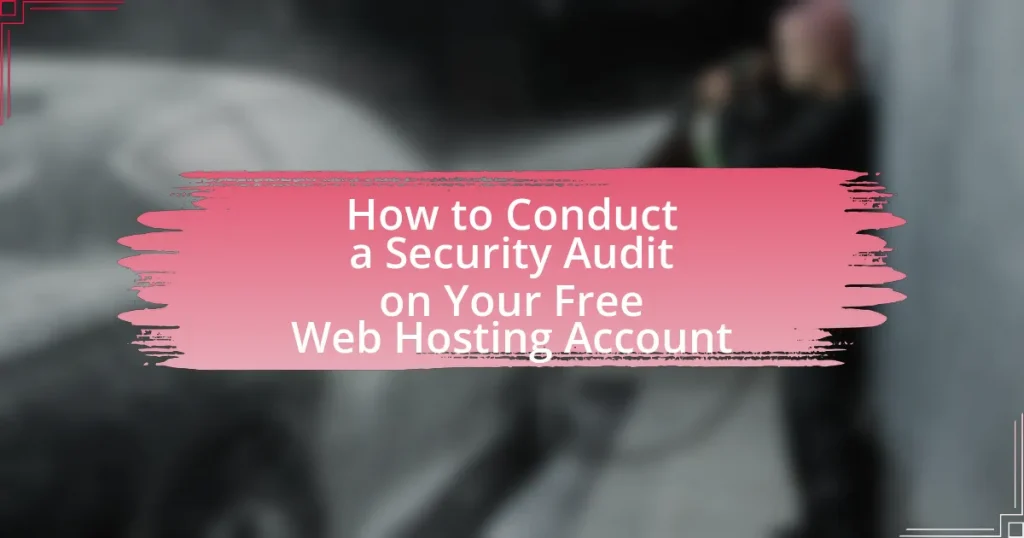A security audit for free web hosting accounts is a critical evaluation of the security measures and vulnerabilities associated with these services. This article outlines the importance of conducting such audits, highlighting potential risks like weak passwords and outdated software that can lead to data breaches. Key components of a security audit, including risk assessment and compliance checks, are discussed, along with tools commonly used for vulnerability scanning. The article also provides practical steps for preparing for an audit, assessing security settings, and implementing best practices to enhance overall security posture. Regular audits are emphasized as essential for mitigating risks and ensuring compliance with security standards.

What is a Security Audit for Free Web Hosting Accounts?
A security audit for free web hosting accounts is a systematic evaluation of the security measures and vulnerabilities associated with a web hosting service that does not charge users. This audit typically involves assessing the hosting provider’s security protocols, examining the account settings, and identifying potential risks such as weak passwords, outdated software, and lack of encryption. According to a study by the Cybersecurity & Infrastructure Security Agency, 90% of data breaches are due to human error, highlighting the importance of regular security audits to mitigate risks and enhance the overall security posture of free web hosting accounts.
Why is conducting a security audit important for free web hosting accounts?
Conducting a security audit is crucial for free web hosting accounts because these accounts often lack robust security measures, making them vulnerable to attacks. Free web hosting services typically do not provide the same level of security features as paid options, which can lead to data breaches, unauthorized access, and loss of sensitive information. A security audit identifies potential vulnerabilities, assesses the effectiveness of existing security protocols, and ensures compliance with best practices, thereby mitigating risks associated with cyber threats.
What are the potential risks associated with free web hosting accounts?
Free web hosting accounts pose several potential risks, including limited security measures, lack of customer support, and potential data loss. These accounts often do not provide robust security features such as SSL certificates or firewalls, making them vulnerable to cyberattacks. Additionally, the absence of reliable customer support can hinder users from resolving issues promptly, leading to prolonged downtime or data breaches. Furthermore, free hosting services may impose restrictions on data storage and bandwidth, increasing the risk of data loss if the service provider shuts down or changes its policies unexpectedly.
How can a security audit mitigate these risks?
A security audit can mitigate risks by identifying vulnerabilities and weaknesses in a web hosting account’s security posture. Through systematic evaluation, the audit uncovers potential threats such as outdated software, misconfigurations, and inadequate access controls. For instance, a study by the Ponemon Institute found that organizations that conduct regular security audits reduce their risk of data breaches by up to 50%. By addressing the findings from the audit, organizations can implement necessary security measures, thereby enhancing their overall security and reducing the likelihood of successful cyberattacks.
What are the key components of a security audit?
The key components of a security audit include risk assessment, vulnerability assessment, compliance checks, and security controls evaluation. Risk assessment identifies potential threats and their impact on the organization, while vulnerability assessment involves scanning for weaknesses in systems and applications. Compliance checks ensure adherence to relevant regulations and standards, such as GDPR or HIPAA. Finally, evaluating security controls examines the effectiveness of existing measures in protecting assets. These components collectively provide a comprehensive overview of an organization’s security posture, enabling informed decision-making for improvements.
What tools are commonly used in security audits for web hosting?
Commonly used tools in security audits for web hosting include Nessus, OpenVAS, and Burp Suite. Nessus is a widely recognized vulnerability scanner that identifies potential security issues in web applications and servers. OpenVAS is an open-source alternative that provides comprehensive vulnerability scanning and management. Burp Suite is a popular tool for web application security testing, allowing for manual and automated testing of web applications. These tools are essential for identifying vulnerabilities, ensuring compliance, and enhancing the overall security posture of web hosting environments.
How do you assess the security settings of your hosting account?
To assess the security settings of your hosting account, begin by reviewing the account’s access controls, including user permissions and password strength. This involves checking who has access to your account and ensuring that only authorized users have the necessary permissions. Additionally, verify that strong, unique passwords are in place and consider implementing two-factor authentication for added security.
Next, examine the hosting provider’s security features, such as firewalls, DDoS protection, and SSL certificates. Ensure that these features are enabled and properly configured to protect your data and website from potential threats.
Finally, conduct regular security audits by monitoring logs for suspicious activity and keeping software and plugins updated to mitigate vulnerabilities. According to a report by the Cybersecurity & Infrastructure Security Agency, regular updates and monitoring can significantly reduce the risk of security breaches.

How do you prepare for a security audit on your free web hosting account?
To prepare for a security audit on your free web hosting account, first, conduct a comprehensive review of your account settings and configurations. This includes checking user permissions, ensuring strong passwords, and verifying that software and plugins are up to date. Additionally, assess the security measures provided by the hosting service, such as SSL certificates and firewalls, to confirm they are properly implemented. Regularly backing up your data is also crucial, as it ensures recovery in case of a security breach. According to a 2021 report by Cybersecurity Ventures, 60% of small businesses that experience a cyber attack go out of business within six months, highlighting the importance of thorough preparation for security audits.
What preliminary steps should you take before starting the audit?
Before starting the audit, you should gather all relevant documentation and access credentials for the web hosting account. This includes reviewing the hosting provider’s terms of service, security policies, and any previous audit reports. Additionally, ensure that you have the necessary permissions to conduct the audit, as unauthorized access can lead to legal issues. Establishing a clear scope for the audit is also crucial, as it defines what will be assessed and helps in focusing the audit efforts effectively. These preliminary steps are essential to ensure a thorough and compliant audit process.
How do you gather necessary information about your hosting account?
To gather necessary information about your hosting account, access the hosting provider’s control panel or dashboard. This interface typically contains vital details such as account credentials, server specifications, and resource usage statistics. Additionally, reviewing the welcome email or documentation provided during account setup can reveal essential information like account limits, billing cycles, and support contacts. These sources are reliable as they are directly provided by the hosting service and are crucial for effective management and security auditing of the hosting account.
What documentation should you review prior to the audit?
Prior to the audit, you should review the security policies, access logs, and previous audit reports related to your free web hosting account. Security policies outline the protocols and measures in place to protect data, while access logs provide insights into who accessed the account and when, helping identify any unauthorized access. Previous audit reports offer a historical perspective on vulnerabilities and compliance issues, allowing for a more informed assessment during the current audit.
What specific areas should you focus on during the audit?
During the audit of a free web hosting account, focus on the following specific areas: security configurations, access controls, data protection measures, and compliance with relevant regulations. Security configurations should include checking for SSL certificates, firewall settings, and software updates to ensure vulnerabilities are minimized. Access controls involve reviewing user permissions and authentication methods to prevent unauthorized access. Data protection measures should assess backup procedures and encryption practices to safeguard sensitive information. Compliance with regulations, such as GDPR or CCPA, ensures that the hosting account adheres to legal standards for data privacy and security.
How do you evaluate user access and permissions?
To evaluate user access and permissions, conduct a systematic review of user roles and their associated privileges within the system. This involves identifying all users, categorizing them based on their roles, and assessing the permissions granted to each role against the principle of least privilege, which states that users should only have access necessary for their tasks. Regular audits, such as reviewing access logs and permission settings, help ensure compliance with security policies and identify any unauthorized access or excessive permissions. Implementing tools like access management software can further streamline this evaluation process by providing detailed reports on user activities and access levels.
What security measures should be checked for data protection?
To ensure data protection, security measures that should be checked include encryption, access controls, regular backups, and security patches. Encryption protects data at rest and in transit, making it unreadable to unauthorized users. Access controls limit who can view or modify data, reducing the risk of breaches. Regular backups ensure data can be restored in case of loss or corruption, while security patches address vulnerabilities in software that could be exploited by attackers. According to the 2021 Verizon Data Breach Investigations Report, 61% of breaches involved credential data, highlighting the importance of robust access controls.

What are the common vulnerabilities found in free web hosting accounts?
Common vulnerabilities found in free web hosting accounts include weak passwords, lack of security updates, and inadequate server configurations. Weak passwords can be easily exploited through brute force attacks, while the absence of regular security updates leaves accounts susceptible to known exploits. Additionally, many free hosting services do not implement proper server configurations, which can lead to issues like directory listing and file permissions vulnerabilities. According to a study by the Cybersecurity & Infrastructure Security Agency, over 80% of data breaches involve weak or stolen passwords, highlighting the critical need for strong password policies in web hosting environments.
What types of security threats are prevalent in free web hosting environments?
Free web hosting environments are particularly vulnerable to several types of security threats, including malware infections, data breaches, and phishing attacks. Malware infections can occur due to inadequate security measures, allowing malicious software to compromise hosted websites. Data breaches are common as free hosting services often lack robust encryption and access controls, making sensitive information susceptible to unauthorized access. Phishing attacks exploit the trust users place in free hosting services, leading to the theft of personal information. According to a report by the Cybersecurity & Infrastructure Security Agency, free hosting platforms are frequently targeted due to their lower security standards compared to paid services, highlighting the increased risk for users.
How can outdated software contribute to vulnerabilities?
Outdated software contributes to vulnerabilities by lacking the latest security patches and updates that protect against known threats. When software is not regularly updated, it becomes an easy target for cyber attackers who exploit these unpatched vulnerabilities. For instance, a study by the Ponemon Institute found that 60% of data breaches are linked to unpatched vulnerabilities, highlighting the critical need for timely software updates to mitigate risks.
What role do weak passwords play in security breaches?
Weak passwords significantly increase the likelihood of security breaches by making it easier for attackers to gain unauthorized access to systems. Research indicates that 81% of hacking-related breaches leverage stolen or weak passwords, highlighting their critical role in compromising security. Weak passwords are often simple, predictable, or reused across multiple accounts, which allows attackers to exploit them through techniques such as brute force attacks or credential stuffing. Consequently, the prevalence of weak passwords directly correlates with the frequency and success of security breaches in various online platforms.
How can you identify and address these vulnerabilities?
To identify and address vulnerabilities in a free web hosting account, conduct a comprehensive security audit that includes scanning for outdated software, weak passwords, and misconfigured settings. Utilize tools such as vulnerability scanners, which can detect known security flaws in applications and server configurations. For example, tools like Nessus or OpenVAS can provide detailed reports on vulnerabilities present in the hosting environment.
Additionally, implement strong password policies and enable two-factor authentication to mitigate unauthorized access risks. Regularly update all software components, including content management systems and plugins, to patch known vulnerabilities. According to a 2021 report by the Cybersecurity and Infrastructure Security Agency, 85% of successful breaches exploit known vulnerabilities that could have been mitigated through timely updates. This highlights the importance of proactive vulnerability management in maintaining a secure web hosting environment.
What steps can you take to strengthen your account security?
To strengthen your account security, implement strong, unique passwords for each account and enable two-factor authentication (2FA) wherever possible. Strong passwords should be at least 12 characters long, combining uppercase letters, lowercase letters, numbers, and symbols, which significantly reduces the risk of unauthorized access. According to a study by the National Institute of Standards and Technology (NIST), using 2FA can block 99.9% of automated attacks, making it a critical step in enhancing security. Regularly updating passwords and monitoring account activity for suspicious behavior further fortifies your security measures.
How do you implement best practices for password management?
To implement best practices for password management, utilize strong, unique passwords for each account and employ a password manager to securely store them. Strong passwords should be at least 12 characters long, incorporating a mix of uppercase letters, lowercase letters, numbers, and special characters, as recommended by the National Institute of Standards and Technology (NIST). Additionally, enable two-factor authentication (2FA) wherever possible to add an extra layer of security. Regularly update passwords and avoid reusing them across different sites to mitigate the risk of credential stuffing attacks, which have been shown to compromise accounts when passwords are reused.

What are the best practices for conducting a security audit on your free web hosting account?
To conduct a security audit on your free web hosting account, start by reviewing your account settings and permissions to ensure they are configured securely. This includes checking user access levels, disabling unused accounts, and ensuring strong passwords are in place. Next, assess the security features provided by the hosting service, such as SSL certificates, firewalls, and backup options, to confirm they are enabled and functioning correctly. Additionally, regularly scan your website for vulnerabilities using tools like Sucuri or Qualys, which can identify potential security risks. Finally, keep your software and plugins updated to protect against known vulnerabilities, as outdated components are a common entry point for attackers. These practices are essential for maintaining the integrity and security of your web hosting account.
How often should you conduct security audits on your hosting account?
You should conduct security audits on your hosting account at least quarterly. Regular audits help identify vulnerabilities and ensure compliance with security standards. According to the National Institute of Standards and Technology (NIST), frequent assessments are crucial for maintaining a secure environment, as they allow for timely detection of potential threats and weaknesses.
What factors influence the frequency of security audits?
The frequency of security audits is influenced by several key factors, including regulatory requirements, organizational risk tolerance, and the complexity of the IT environment. Regulatory requirements often mandate specific audit intervals to ensure compliance with standards such as GDPR or HIPAA, which can dictate how often audits must occur. Organizational risk tolerance determines how frequently audits are conducted based on the perceived risk of security breaches; higher risk environments may necessitate more frequent audits. Additionally, the complexity of the IT environment, including the number of systems and applications in use, can increase the need for regular audits to identify vulnerabilities and ensure security measures are effective.
How can regular audits improve your overall security posture?
Regular audits enhance your overall security posture by identifying vulnerabilities and ensuring compliance with security policies. These systematic evaluations help organizations detect weaknesses in their systems, processes, and controls, allowing for timely remediation. For instance, a study by the Ponemon Institute found that organizations that conduct regular security audits reduce the average cost of a data breach by 30%. By continuously monitoring and assessing security measures, organizations can adapt to evolving threats and maintain a robust defense against potential attacks.
What practical tips can enhance your security audit process?
To enhance your security audit process, implement a structured checklist that covers all critical areas of your web hosting environment. This checklist should include items such as verifying user access controls, ensuring software updates are applied, and reviewing security configurations. Research indicates that organizations using structured checklists during audits can reduce security vulnerabilities by up to 30%, as they help ensure no critical areas are overlooked. Additionally, conducting regular training sessions for your team on security best practices can further strengthen your audit process, as informed personnel are less likely to make errors that could compromise security.
How do you create a checklist for your security audit?
To create a checklist for your security audit, begin by identifying key areas of focus such as data protection, access controls, and compliance requirements. Next, outline specific items under each area, including verifying encryption methods, assessing user permissions, and ensuring adherence to relevant regulations like GDPR or HIPAA. For example, a checklist might include tasks like “Review firewall settings,” “Check for software updates,” and “Conduct vulnerability scans.” This structured approach ensures comprehensive coverage of security aspects, facilitating a thorough audit process.
What resources are available for ongoing security education?
Ongoing security education resources include online courses, webinars, certifications, and industry publications. Platforms like Coursera and Udemy offer courses on cybersecurity fundamentals, while organizations such as CompTIA and (ISC)² provide certifications that enhance knowledge and skills. Additionally, resources like the SANS Institute and the National Institute of Standards and Technology (NIST) publish guidelines and best practices that are essential for staying updated in the field. These resources are widely recognized and utilized by professionals to maintain and improve their security expertise.















